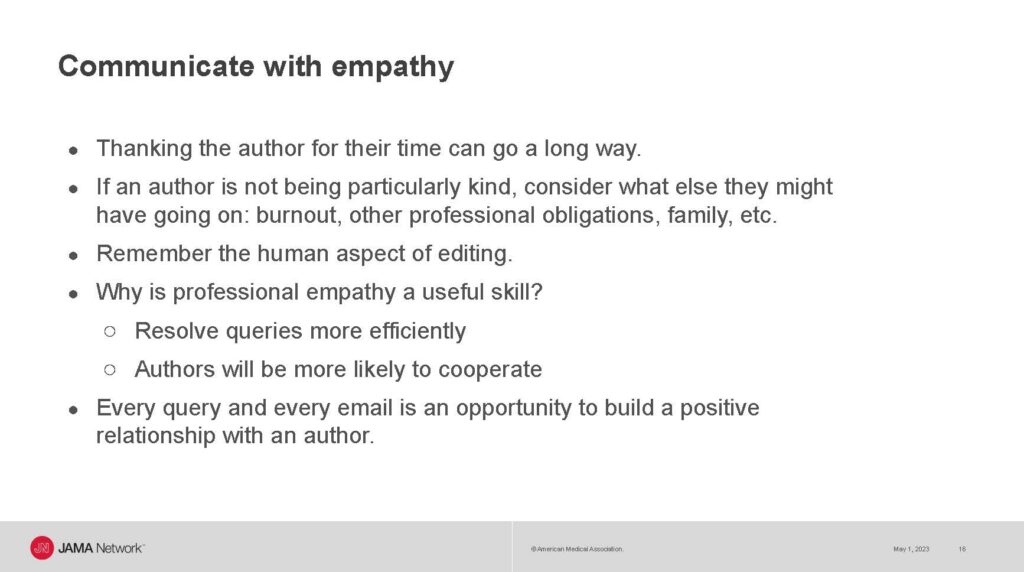MODERATOR:
Amy McPherson
Director of Publications
Botanical Society of America
SPEAKERS:
Jessica LaPointe
Managing Copy Editor
American Meteorological Society
Peter J Olson
Freelance Manuscript Editing Coordinator
JAMA Network
Iris Y Lo
Assistant Deputy Managing Editor
JAMA Network
REPORTER:
Heather DiAngelis
Transportation Research Board at the National Academies of Sciences, Engineering, and Medicine
@hdiangelis
On the first full day of sessions at the 2023 CSE Annual Meeting, Jessica LaPointe, Managing Copy Editor at the American Meteorological Society, kicked off the “Collaborative Copy Editing: Helping the Author Help You” session. Her presentation, titled, “Editing when English Is a Foreign Language: Best Practices and Keys for Efficiency,” took a broad approach to working with authors. She noted that we should respect authors’ language skills as well as their expertise. With a wide variety of linguistic diversity among authors, there’s a real need for quality copyediting. Publishers, authors, and copy editors are all part of the same team with the same goals, which is all the more reason to work together to achieve quality writing.
LaPointe offered several tips for copy editors in these scenarios: (1) contact the author early in the process to establish a relationship and rapport; (2) edit with confidence—by trusting your instincts and using your best judgment—in order to minimize queries to the author; (3) tap your knowledge base of colleagues and friends to help answer questions that arise; (4) automate wherever possible, such as with Word’s search function, to improve efficiency and reduce errors; (5) learn when it Is appropriate to let problems go and relax rigid guidelines; and (6) be patient and courteous, and remember how confusing English can be for even native speakers.
Peter Olson, Freelance Manuscript Editing Coordinator at the JAMA Network, spoke next with a presentation titled, “Effective Author Querying.” He began with a reminder of the challenges authors face, including busy schedules, tight deadlines, and a wide range of expectations and publishing experience. He noted that, “Writing an effective author query is not unlike writing an effective short story,” because queries must often contain complex concepts with minimal text. For maximum effectiveness, author queries should be clear, concise, consistent, accurate, and professional—taken together, these are the core tenets of author querying. Olson provided the example of changing a query of “Please provide.” to “Please provide an exact date of access for reference 23 (month, day, year).” Copyediting can be eased with the use of standard queries (which have the added benefit of reducing edit time and ensuring that each author receives the same message) and global queries (to reduce an overwhelming number of queries).
Copy editors should also be careful to avoid “mixed bag” queries, which Olson defined as “queries that address multiple specific requests”; this is particularly the case if the queries are lengthy and/or unrelated. Furthermore, consider the format in which the author will view the queries; for instance, a clean-copy PDF with no tracked changes might require different wording than a Word file showing tracked changes. At the end of editing, Olson noted, always double check queries for completeness and accuracy; if anything in the text has changed, such as reference numbering, the queries might need to be updated to avoid author confusion.
Iris Lo, Assistant Deputy Managing Editor at the JAMA Network, continued the session with the presentation, “Respectful Query Resolution,” to address problems that occur after initial querying. One potential scenario is when errors are unintentionally introduced early; in this case, the copy editor should learn to pinpoint how the error happened and double check the work, and then briefly describe the workflow to the author to explain how the error was introduced—without overexplaining. A second common scenario is when an author may not understand why certain edits were made; if so, the copy editor should offer an explanation of the edits, potentially using style guide excerpts. She noted that copy editors should remember to be flexible, as not every style rule holds the same weight. In later rounds of edits, an author might need more context, such as when the copyeditor can implement a requested change but must revise it per style or when the copy editor cannot accommodate a change and must let the author know why. Communicating with empathy is key and can go a long way (Figure). “Every query and every email,” she said, “is an opportunity to build a positive relationship with an author.”

Moderator Amy McPherson, Director of Publications at the Botanical Society of America, wrapped up the session with a reminder of the importance of global collaboration and opening borders in scholarly publishing. She then launched a question-and-answer period with the audience, which addressed the balance of breaking editing rules versus following style, how a manager can best support copyediting employees and freelancers in tough situations, and what copy editors can expect from authors up-front.
https://doi.org/10.36591/SE-D-4604-02
